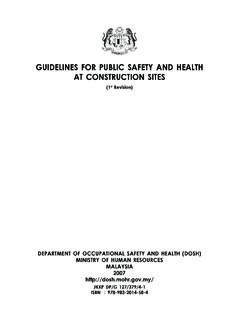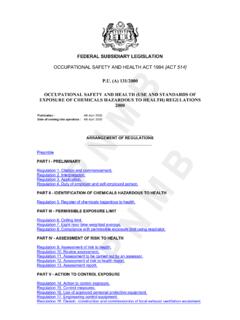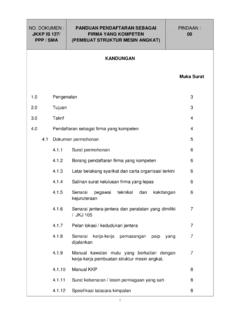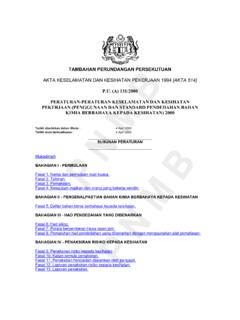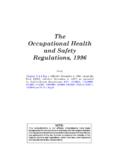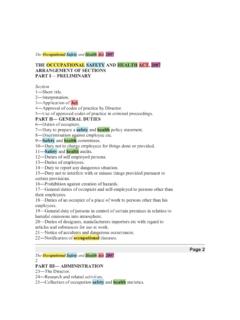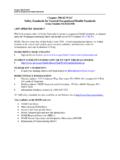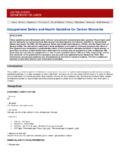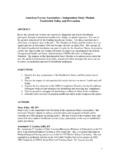Transcription of GUIDELINES ON OCCUPATIONAL SAFETY AND …
1 [a] GUIDELINES ON OCCUPATIONAL SAFETY AND health management SYSTEMS Ministy of Human Resources Department of OCCUPATIONAL SAFETY and health [b] Printed by Mashi Publication Sdn Bhd. No 68. Jalan Mas Jaya 1, Kawasan Perindustrian Mas Jaya, 43200 Batu 9 Cheras, Selangor Phone : 03-9076 6311 Fax : 30-9075 4311 Email : CONTENTS Page iii iv 1 SCOPE AND 1 1 1 2 TERMS AND 2 3 THE OSH MS IN THE 6 10 OCCUPATIONAL SAFETY and health 10 Employee 14 16 Responsibility and accountability and 17 Competence and training and 18 OSH MS 21 25 Planning and 27 Initial 27 OCCUPATIONAL SAFETY and health 29 32 Emergency Preparedness and 38 management of 42 Procurement .. 43 44 Evaluation .. 45 Performance monitoring and 40 Incident Investigation.
2 48 49 management 52 Action for 55 Preventive and corrective 48 Continual 56 BIBLIOGRAPHY 68 [ii] LIST OF FIGURE 1. OSH 6 2. Implementation 7 3. The 21 LIST OF TABLE 1. The Conceptual sub element in OSH management System 9 LIST OF ANNEX 1. Annex 1: Example of SAFETY and health 58 2. Annex 2: Example of Training 59 3. Annex 3: Example of Training 59 4. Annex 4: Example of Emergency management 60 5. Annex 5: The Legal 62 6. Annex 6: 63 7. Annex 7: Incident 66 8. Annex 8: Checklist Compliance 67 9. Annex 9: Correction 67 [iii] ACKNOWLEDGEMENTS These GUIDELINES have been prepared through the joint effort of the Department of OCCUPATIONAL SAFETY and health , representative from government agencies, higher learning institutions and professional.
3 The Department of OCCUPATIONAL SAFETY and health would particularly like to thank the following organisation and distinguished individuals for their most valuable contributions during the drafting of the GUIDELINES . The Technical Committee on OSHMS GUIDELINES and consists of representatives from the following organisations: Mr Ir Hj Saiful Azhar Mohd Said (Chairman) Department of OCCUPATIONAL SAFETY and health Mrs Ramuna Mohamed Department of OCCUPATIONAL SAFETY and health Mrs Noria Mohamad/ Mrs Khushaida Ahmad Khiri/ Mrs Nur Fahkis Anuar/ Mrs Norsalnita Md Noor (Secretary) Dr Marzuna Md Yunus/ Department of Veterinary Services Dr Masturi Mahmud Mr Ir Hj Hussein Rahmat Hanaka management Services Mr Hj Anis Fahmy Pauzi Malaysian Employers Federation Mr Matdiah Mohammad Malaysian Trade Union Congress Mr Ahmad Nazmi Mohamed Ali Master Builders Association Malaysia Dr Priya Ragunath Ministry of health , Malaysia Major Hanif Maidin (Rtd)
4 National Institute of OCCUPATIONAL SAFETY and health Mr Iskandar Syahril Ibrahim Sukri/ NIOSH Certification Sdn Bhd Mr Hamdan Hj Ramat/ Dr Mohd Rafee Baharudin Ms Salwa Denan SIRIM Berhad Mrs Norafiza Saim SIRIM QAS International Berhad Mr Harun Bakar Social Security Organisation Mr Hj Azman Abdul Aziz/ The Malayan Agricultural Producers Association Mr Mohd Azlirahizal Abdul Kadir Prof Dr Mansor Ahmad Universiti Putra Malaysia Prof Dr Ismail Bahari Universiti Kebangsaan Malaysia [iv] FOREWORD This guideline has been developed to guide and assist organizations on the implementation of the MS1722: OCCUPATIONAL SAFETY and health management Systems - Requirements standard. It is developed in replacement of the MS 1722: Part 2:2003 - OCCUPATIONAL SAFETY and health management Systems - GUIDELINES standard which has been withdrawn by Standards Malaysia.
5 The development of this guideline is a smart collaborative effort from regulatory body, institution of higher learning, consultant, the industry association, NGOs, employees association, employers association and certification bodies with the aim to support the objective of the OSH-MP15. The guideline is intended to assist organizations to develop and implement an effective OSHMS that can be integrated with other management systems. The implementation of an effective OSHMS is crucial for an organization to achieve a sound OSH performance and to comply with legal requirements. Organizations of all industries, types and sizes may use this guideline as it provides generic assistance for establishing, implementing and improving an OSHMS. This guideline is divided into four main parts, Part I brief explanation on scope and purpose about OSHMS. Terms and definitions gives based on MS1722: OCCUPATIONAL SAFETY and health management Systems-Requirement standard in Part II.
6 Explanation and described the OSHMS elements is given in the Part III. Part IV gives examples of form and checklist for references and implementation the OSHMS. Director General Department of OCCUPATIONAL SAFETY and health 2011 [1] OCCUPATIONAL SAFETY AND health management SYSTEMS - GUIDELINES 1. SCOPE AND PURPOSE Scope This guideline provides generic advice on the application on MS1722:2011 OCCUPATIONAL SAFETY and health management System. It explains each requirements of MS1722 in steps and contains some example of forms and checklist to assist the user. Purpose This guideline is to provide direction and assistance in implementing OCCUPATIONAL SAFETY and health management System (OSHMS) that can contribute to the protection of employees from hazards and its associated risks, the elimination of work-related injuries, disabilities, ill health , diseases, near misses and fatalities.
7 This guideline is intended to: interpret the requirement MS1722:2011 assist compliance to legal requirements ensure continual improvement in OSH performance cultivate OSH culture in organisation [2] 2. TERMS AND DEFINITIONS For the purpose of this document, the following terms and definitions given in MS1722 apply. active monitoring The ongoing activities, which check that hazard and risk preventive and protective measures, as well as the arrangements to implement the OSHMS, conform to the defined criteria. arrangements Act of planning, scheduling, arranging and adapting activities to meet the desired set objectives. Arrangements could include systems, programs, activities, processes, procedures, records and instructions. Such arrangements are communicated and where appropriate documented. audit A systematic, independent and documented process for obtaining evidence and evaluating it objectively to determine the extent to which the defined criteria are fulfilled.
8 Competent person A person determined by the employer or authorities to have suitable training, and sufficient knowledge, experience and skill, for the performance of the specific work. continual improvement Iterative process of enhancing the OSHMS to achieve improvements in the overall OSH performance. contractor A person or an organisation providing services to an employer in accordance with agreed specifications, terms and conditions. corrective action Action to eliminate the cause of a detected nonconformity or other undesirable situation. NOTES: 1: There can be more than one cause for a nonconformity. 2: Corrective action is taken to prevent recurrence whereas preventive action is taken to prevent occurrence. disability Any injury other than death which results in the partial loss, or complete loss of use of any member or part of a member of the body, or any permanent impairment of functions of the body or part thereof, regardless of any pre-existing disability of the injured member or impaired body function.
9 MS1722: 2011 REQUIREMENTS [3] employee Any person who perform work, either regularly or temporarily, for an employer. employer The owner of an organisation or the person with whom an employee has entered into a contract of service. hazard A source, situation, or act with a potential for harm in terms of human injury or ill health and damage to property. ill health Identifiable, adverse physical or mental condition arising from and/or made worse by a work activity and/or work-related situation. incident Work-related event(s) in which an injury or ill- health (regardless of severity) or fatality or damage to property or could have occurred; NOTES: 1: An accident is an incident which has given rise to injury, ill health or fatality. 2: An incident where no injury, ill health or fatality occurs may also be referred to as a near-miss , near hit , close-call or dangerous occurrence.
10 3: An emergency situation is a particular type of incident. near miss An unsafe occurrence arising out of or in the course of work where no, human injury or ill health , damage to property, damage to the environment is caused. organisation A company, operation, firm, undertaking, establishment, enterprise, institution or association, or part of it, whether incorporated or not, public or private, that has its own functions and administration. [4] OSH management System (OSHMS) A set of interrelated or interacting elements to establish and implement OSH policy and objectives, and to achieve those objectives. OSHMS is part of the organisation's overall management system used to manage OSH risks. NOTE: A management system includes organisational structure, planning activities (including for example, risk assessment and the setting of objectives), responsibilities, practices, procedures, processes and resources.
